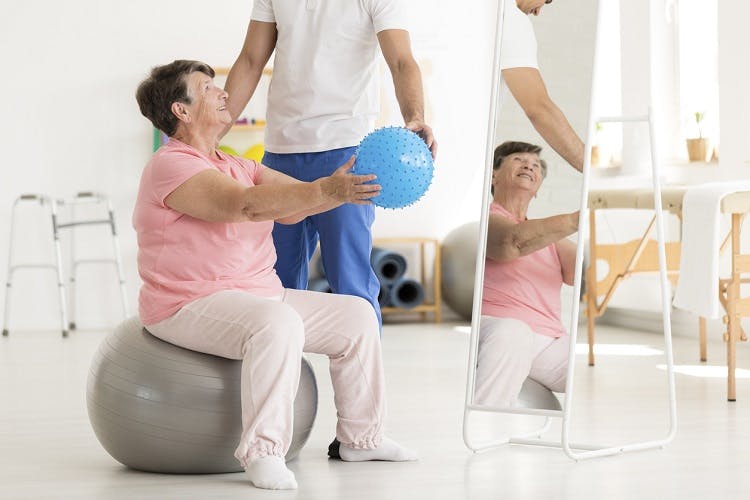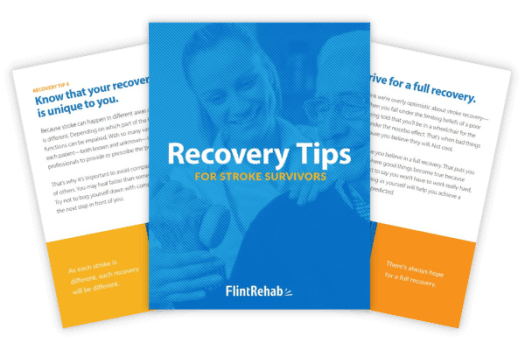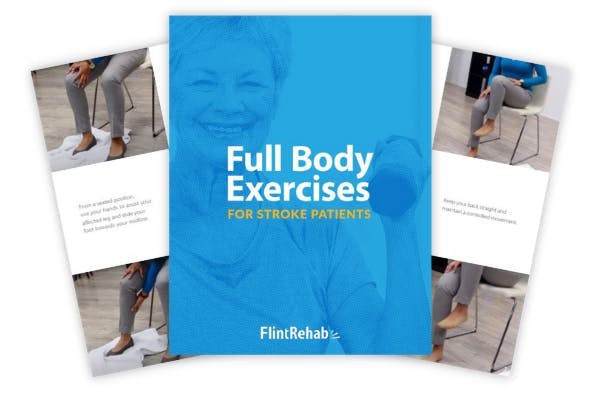No products in the cart.
No products in the cart.
No products in the cart.
No products in the cart.
Home » Neurological Recovery Blog » Stroke » Understanding Ataxia in Stroke Patients: A Cerebellar Stroke Effect
Last updated on January 27, 2022

A stroke that affects the cerebellum can cause problems with coordination and muscle control. This means that your nervous system may struggle to coordinate movement, which is a condition known as ataxia.
In this article, we’ll share why ataxia after stroke is associated with the cerebellum and how it’s addressed through rehabilitation.
The cerebellum is an area of the brain that controls coordination, balance, and voluntary muscle movements.
Movement begins from signals that are sent between your brain and muscles. While it sounds like a simplistic process, it involves many different functions and areas of the brain, including the cerebellum.
One of the main roles of the cerebellum is to modify motor signals or commands to improve the accuracy and coordination of body movements. When the cerebellum is damaged by a stroke or brain injury, then ataxia can occur.
A stroke occurs when the supply of blood in the brain is compromised by a clogged or burst artery. When a stroke affects the cerebellum, it can damage healthy brain tissue and impair cerebellar function.
Ataxia can affect different muscles in the body and result in various impairments.
For instance, when the legs and trunk are affected, it can create difficulty with balance and walking. Or, when the oral muscles are affected, ataxia can contribute to slurred speech.
Ataxia manifests differently in everyone. Here are some signs of ataxia in stroke patients to look for:
It’s important to work with your physician or therapist to discuss any motor issues you may have and design a unique treatment plan for you.
While there is no medication that can cure damage to the cerebellum (or any other area of the brain), improvements are often possible through rehabilitation.
Because ataxia stems from miscommunication within the brain, rehabilitation focuses compensatory strategies. This is possible thanks to neuroplasticity: the brain’s ability to create and strengthen neural connections within the healthy areas.
Neuroplasticity is how all skills are learned, and this is how skills such as balance can be re-learned after a stroke.
When a skill is practiced regularly, the brain become more efficient by strengthening the neural pathways required to execute that function. This is why riding a bike regularly helps improve your ability to ride a bike.
It’s important to emphasize that ataxia is caused by miscommunication within the brain as opposed to a loss of muscle strength. After a stroke, patients can experience a loss of coordination even when muscle strength has been relatively well-preserved.
Therefore, improving coordination after ataxia is a matter of practicing coordinated movement. As you’ll see next, there are many therapies available that help with this.
Ataxia can affect movement in any area of the body, so there are a wide variety of therapies available based on your symptoms.
Below is a list of rehabilitative therapies to help treat ataxia in stroke patients:
During physical therapy, your therapist will guide you through specific exercises to help improve balance and coordination. Your therapist will likely focus on exercises for the legs and trunk because these muscle groups are often affected by ataxia.
It’s important to keep up with physical therapy exercises on your own at home to keep the brain stimulated and encourage neuroplasticity. This is where home therapy programs can help, such as Flint Rehab’s FitMi home therapy.
FitMi helps stroke survivors regain movement by motivating you to accomplish high repetition of physical therapy exercises. Users can select which muscles to target, such as the legs and trunk, which can help address ataxia.
Occupational therapy also helps individuals regain mobility, particularly with the activities of daily living such as eating. When ataxia affects your ability to use the bathroom on your own, for example, an occupational therapist will help you with this goal (either through rehabilitation exercise or compensation techniques).
If ataxia causes slurred speech, a Speech-Language Pathologist can help. It’s important to work closely with an SLP because these experts understand the differences between speech conditions.
For instance, apraxia of speech is different than aphasia, another speech disorder that can occur after a stroke. Apraxia of speech is a motor disorder (affecting the oral muscles) while aphasia is a linguistic disorder (affecting various cognitive aspects of speech such as reading or comprehension).
Both conditions are treated with different exercises, which makes it essential to be diagnosed by an SLP before beginning speech therapy exercises.
Every stroke is different and every recovery is different. The best therapy for ataxia after stroke depends upon the individual’s unique symptoms.
Work closely with your therapists to create a rehabilitation regimen that targets your specific goals. Then, keep up with therapy on your own between visits with your therapist. The brain requires consistent stimulation to rewire itself and re-learn skills such as coordinated movement. As you put in the work and practice therapeutic exercises for apraxia, your coordination can continue to improve over time.

Get our free stroke recovery ebook by signing up below! It contains 15 tips every stroke survivor and caregiver must know. You’ll also receive our weekly Monday newsletter that contains 5 articles on stroke recovery. We will never sell your email address, and we never spam. That we promise.


Do you have these 25 pages of rehab exercises?
Get a free copy of our ebook Full Body Exercises for Stroke Patients. Click here to get instant access.
“My name is Monica Davis but the person who is using the FitMi is my husband, Jerry. I first came across FitMi on Facebook. I pondered it for nearly a year. In that time, he had PT, OT and Speech therapy, as well as vision therapy.
I got a little more serious about ordering the FitMi when that all ended 7 months after his stroke. I wish I hadn’t waited to order it. He enjoys it and it is quite a workout!
He loves it when he levels up and gets WOO HOOs! It is a wonderful product! His stroke has affected his left side. Quick medical attention, therapy and FitMi have helped him tremendously!”
FitMi is like your own personal therapist encouraging you to accomplish the high repetition of exercise needed to improve.
When you beat your high score or unlock a new exercise, FitMi provides a little “woo hoo!” as auditory feedback. It’s oddly satisfying and helps motivate you to keep up the great work.
In Jerry’s photo below, you can see him with the FitMi pucks below his feet for one of the leg exercises:
Many therapists recommend using FitMi at home between outpatient therapy visits and they are amazed by how much faster patients improve when using it.
It’s no surprise why over 14,000 OTs voted for FitMi as “Best of Show” at the annual AOTA conference; and why the #1 rehabilitation hospital in America, Shirley Ryan Ability Lab, uses FitMi with their patients.
This award-winning home therapy device is the perfect way to continue recovery from home. Read more stories and reviews by clicking the button below:
Grab a free rehab exercise ebook!
Sign up to receive a free PDF ebook with recovery exercises for stroke, traumatic brain injury, or spinal cord injury below: